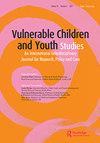高中生智能手机成瘾与社交孤独关系的调查
IF 0.9
Q4 FAMILY STUDIES
引用次数: 3
摘要
摘要本研究旨在评估高中生智能手机成瘾与社交孤独和情感孤独之间的关系。它计划是描述性和横断面的。这项研究是在2019年11月至12月期间进行的。本研究采用《学生识别表》、《智能手机成瘾简易量表》和《社交与情感孤独量表》收集数据。在数据的统计分析中,采用数字、百分比值、独立样本t检验、方差分析、相关分析和回归分析。学校类型、收入状况、每天上网时间、拥有电脑和智能手机的状态、智能手机成瘾量表平均得分之间的差异有统计学意义(p < 0.05)。智能手机的使用与社交和情感孤独呈正相关(r = 0.216, p = 0.001)。每日互联网使用、智能手机使用时间和社交媒体参与度预测智能手机成瘾的比例为36% (R2 = 0.36, p < 0.001)。高中生智能手机成瘾与孤独感之间存在显著关系。本文章由计算机程序翻译,如有差异,请以英文原文为准。
‘Investigation of the relationship between smartphone addiction and social loneliness in high school students’
ABSTRACT This study was carried out with the aim of evaluating the relationship between smartphone addiction and social and emotional loneliness in high school students. It was planned to be descriptive and cross-sectional. This study was conducted between November and December 2019. ‘Student Identification Form’, ‘Smartphone Addiction Scale – Short Form’ and Social and Emotional Loneliness Scale were used to collect data in the study. In the statistical analysis of the data, number, percentage values, independent samples t-test, ANOVA, correlation and regression were used. A statistically significant difference was found between school type, income status, daily internet usage time, the state of having a computer and smartphone, and smartphone addiction scale mean scores (p < 0.05). A positive correlation was found between smartphone usage and social and emotional loneliness (r = 0.216, p = 0.001). Daily internet usage, smartphone usage time, and social media engagement predicted smartphone addiction by 36% (R2 = 0.36, p < 0.001). A significant relationship was found between smartphone addiction and loneliness in high school students.
求助全文
通过发布文献求助,成功后即可免费获取论文全文。
去求助
来源期刊

Vulnerable Children and Youth Studies
FAMILY STUDIES-
CiteScore
1.90
自引率
0.00%
发文量
33
期刊介绍:
Vulnerable Children and Youth Studies is an essential peer-reviewed journal analyzing psychological, sociological, health, gender, cultural, economic, and educational aspects of children and adolescents in developed and developing countries. This international publication forum provides a much-needed interdisciplinary focus on vulnerable children and youth at risk, specifically in relation to health and welfare issues, such as mental health, illness (including HIV/AIDS), disability, abuse, neglect, institutionalization, poverty, orphanhood, exploitation, war, famine, and disaster.
 求助内容:
求助内容: 应助结果提醒方式:
应助结果提醒方式:


